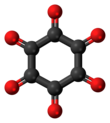Cyclohexanehexone, also known as hexaketocyclohexane and triquinoyl, is an organic compound with formula C6O6, the sixfold ketone of cyclohexane. It is an oxide of carbon (an oxocarbon), a hexamer of carbon monoxide.

| |||
| |||
| Names | |||
|---|---|---|---|
| IUPAC name
cyclohexane-1,2,3,4,5,6-hexone
| |||
| Other names
hexaketocyclohexane, triquinoyl
| |||
| Identifiers | |||
3D model (JSmol)
|
|||
| ChemSpider | |||
| ECHA InfoCard | 100.007.649 | ||
PubChem CID
|
|||
| UNII | |||
CompTox Dashboard (EPA)
|
|||
| |||
| |||
| Properties | |||
| C6O6 | |||
| Molar mass | 168.060 g·mol−1 | ||
Except where otherwise noted, data are given for materials in their standard state (at 25 °C [77 °F], 100 kPa).
| |||
The compound is expected to be highly unstable, even less stable than the cyclohexanehexathione analog, and as of 1999 had only been observed as an ionized fragment during mass spectrometry studies.[1][2]
Related compounds
editCyclohexanehexone can be viewed as the neutral counterpart of the rhodizonate anion C6O2−6. The singly charged anion C6O−6 has been detected in mass spectrometry experiments, formed by oligomerization of carbon monoxide through the formation of molybdenum carbonyls.[3]
According to X-ray diffraction analysis, the reagent traded under the name "cyclohexanehexone octahydrate" or equivalent names is actually dodecahydroxycyclohexane dihydrate—the geminal diol derivative of the six ketone groups with an additional two molecules of water—a solid that decomposes at 95 °C.[4][5]
In 1966, Howard E. Worne of Natick Chemical Industries patented compounds with formulas C10O8 and C14O10, which can be described as the fusion of two or three molecules of C6O6, claimed to be produced by the action of ultraviolet radiation on a hot water solution of the parent compound.[6]
Triquinoyl therapy
editIn the late 1940s, William J. Hale claimed that "triquinoyl", being a trimer of William Frederick Koch's glyoxylide, should be just as effective as the latter against "diabetes, arthritis, poliomyelitis, and even cancer".[7] Even though there is no research supporting this claim (and Koch's glyoxylide preparations were found to be just distilled water),[8] triquinoyl is still listed as an ingredient of some alternative medicine remedies.[9]
See also
edit- Cyclopentanepentone
- Ethylenetetracarboxylic dianhydride, an isomer of C6O6.
- Cyclohexanehexathione, with same structure but with sulfur instead of oxygen.
References
edit- ^ Gunther Seitz; Peter Imming (1992). "Oxocarbons and pseudooxocarbons". Chemical Reviews. 92 (6): 1227–1260. doi:10.1021/cr00014a004.
- ^ Schröder, Detlef; Schwarz, Helmut; Dua, Suresh; Blanksby, Stephen J.; Bowie, John H. (1999). "Mass spectrometric studies of the oxocarbons CnOn (n = 3–6)". International Journal of Mass Spectrometry. 188 (1–2): 17–25. Bibcode:1999IJMSp.188...17S. doi:10.1016/S1387-3806(98)14208-2. ISSN 1387-3806.
- ^ Wyrwas, Richard B.; Jarrold, Caroline Chick (2006). "Production of C6O6– from Oligomerization of CO on Molybdenum Anions". Journal of the American Chemical Society. 128 (42): 13688–13689. doi:10.1021/ja0643927. PMID 17044687.
- ^ Klapötke, Thoman M.; Polborn, Kurt; Weigand, Jan J. (2005). "Dodecahydroxycyclohexane dihydrate". Acta Crystallographica E. 61 (5): o1393–o1395. Bibcode:2005AcCrE..61O1393K. doi:10.1107/S1600536805010007.
- ^ Person, Willis B.; Williams, Dale G. (1957). "Infrared Spectra and the Structure of Leuconic Acid and Triquinoyl". The Journal of Physical Chemistry. 61 (7): 1017–1018. doi:10.1021/j150553a047. ISSN 0022-3654.
- ^ US 3227641, Worne, Howard E., "Polycarbonyls", issued 1996-01-04, assigned to Natick Chemical Industries
- ^ Hale, William J. (1949). "Farmer Victorious—Money, Mart, and Mother Earth" (reprint).[permanent dead link]
- ^ Goodrich, William W. (October 15–16, 1986). "FDA Oral History Interview, Goodrich" (PDF) (Interview). Interviewed by Ronald T. Ottes and Fred L. Lofsvold. p. 31.
- ^ "Import Alert #66-46 – Unapproved Version of Rodaquin". U. S. Food and Drug Administration. 1989. Archived from the original on 2016-11-16. Retrieved 2019-03-09.

